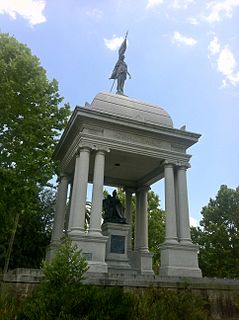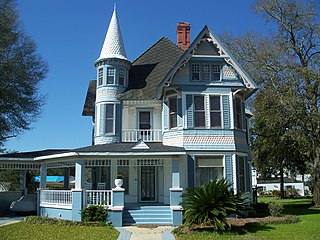
Springfield is a historic neighborhood of Jacksonville, Florida, United States, located to the north of downtown. Established in 1869, it experienced its greatest growth from the early 1880s through the 1920s. The Springfield Historic District is listed in the National Register of Historic Places, and contains some of the city's best examples of 19th and early 20th century architecture.

The Fernandina Beach Historic District is a U.S. historic district located in Fernandina Beach, Florida on Amelia Island. The Fernandina Beach Historic District was included on the National Register on July 20, 1973 and encompasses approximately 1,500 acres, bounded by North 9th Street, Broome, Ash, South 5th Street, Date, and South 8th Street. On April 20, 1987, the National Register listing was expanded to include an additional 970 acres (3.9 km²), bounded by Sixth, Broome, North 3rd, & Escambia Streets; Seventh & Date Streets, and Ash. Approximately 300 buildings are included in this district.

The Old Town Sebastian Historic District West is a United States historic district located in Sebastian, Florida. The district is bounded by Palmetto Ave, Lake and Main Streets. It contains 15 historic buildings.

The DeFuniak Springs Historic District is a U.S. historic district located in DeFuniak Springs, Florida. DeFuniak Springs, originally Lake DeFuniak, was named after Fred DeFuniak, the chief executive of the Louisville and Nashville Railroad. The district is bounded by Nelson and Park Avenues and 2nd and 12th Streets. It contains 172 historic buildings and 2 objects.

The Downtown Miami Historic District is a U.S. historic district located in the CBD of Downtown Miami, Florida. The district is bounded by Miami Court, North Third Street, West Third Avenue, and South Second Street. It contains 60 historic buildings. A large portion the buildings in the historic district were built during the Florida land boom of the 1920s, when Miami experienced rapid population growth. Many of the older structures from before the 1920s, were smaller scale buildings and homes from the Miami pioneer era of the mid and late-19th century. Palm Cottage, built in 1897 is a home from the pioneer era that is still standing, however, few of these original homes remain.

The Old Gainesville Depot is a historic site at 203 Southeast Depot Avenue in Gainesville, Florida. It was added to the U.S. National Register of Historic Places on November 22, 1996. Part of the Depot was built around 1860 to serve the Florida Railroad, which reached Gainesville from Fernandina in 1859. It is one of only three surviving railroad depots in the state built prior to the start of the American Civil War. The depot was situated with tracks on both sides. Between 1892 and 1897 the depot was remodeled to provide two passenger waiting rooms, one for whites and one for Blacks. A new passenger depot with segregated waiting rooms was built in 1910, and the old depot was moved and attached as a freight house to the passenger depot. Depot operations were moved to a new building where East University Avenue crossed the rail line in January, 1948. After the railroad opened the new depot, the old depot building was used by Baird Hardware, Gator Ice and Voyles Appliance store. The City of Gainesville acquired the depot building in 1999.
Pigeon Key is a historic district located on the small island of Pigeon Key in the lower Florida Keys, United States. The island is named "Cayo Paloma" on many old Spanish charts. It is located off the old Seven Mile Bridge, at approximately mile marker 45, west of Knight's Key, and just east of Moser Channel, which is the deepest section of the seven-mile span.
Old Town Historic District may refer to:

Greenport Railroad Station is the terminus of the Main Line of the Long Island Rail Road. It is officially located at Wiggins Street and Fourth Street in the Village of Greenport, New York, although the property spans as far east as 3rd Street and the Shelter Island North Ferry terminal.

This is a list of the National Register of Historic Places listings in Indian River County, Florida.

The Richmond Railroad Station Historic District is a group of historic commercial buildings and national historic district located at Richmond, Wayne County, Indiana. The district encompasses 22 contributing buildings the icon of which is the Daniel Burnham-designed Pennsylvania Railroad Station, completed in 1902. It developed between about 1853 and 1915 and includes representative examples of Italianate, Classical Revival, and Chicago School style architecture. In addition to the Pennsylvania Railroad Station, other notable buildings include the Miller Brothers Block (1890), Jacob H. Lichtenfels Building (1890), Charles Sudhoff Building (1893), Benjamin Starr Building (1896), William H. Alford Building (1905), John Roberts Building (1877), R.F.D. Hose House No. 1 (1890), James Shaw Building (1875), and Richmond / Atlas Underwear Building (1910).

The H. H. Richardson Historic District of North Easton is a National Historic Landmark District in the village of North Easton in Easton, Massachusetts. It consists of five buildings designed by noted 19th-century architect Henry Hobson Richardson, and The Rockery, a war memorial designed by Frederick Law Olmsted. It was declared a National Historic Landmark in 1987.

The Bardstown Historic District, comprising the center of Bardstown, Kentucky, is a registered historic district on the National Register of Historic Places. Prominent architecture located within the district include the Cobblestone Path, Nelson County Jail, Old L & N Station, Old Talbott Tavern, and Spalding Hall, all individually on the National Register, and the historic old Nelson County Courthouse.

Pigeon Key is a small island containing the historic district of Pigeon Key, Florida. The 5-acre (2.0-hectare) island is home to 8 buildings on the National Register of Historic Places, some of which remain from its earliest incarnation as a work camp for the Florida East Coast Railway. Today these buildings serve a variety of purposes, ranging from housing for educational groups to administrative offices for the non-profit Pigeon Key Foundation. The former Assistant Bridge Tender's House has been converted into a small museum featuring artifacts and images from Pigeon Key's colorful past. It is located off the old Seven Mile Bridge, at approximately mile marker 45, west of Knight's Key, and just east of Moser Channel, which is the deepest section of the 7-mile (11 km) span.

The Greenwich Avenue Historic District is a historic district representing the commercial and civic historical development of the downtown area of the town of Greenwich, Connecticut. The district was listed on the National Register of Historic Places on August 31, 1989. Included in the district is the Greenwich Municipal Center Historic District, which was listed on the National Register the year before for the classical revival style municipal buildings in the core of Downtown. Most of the commercial buildings in the district fall into three broad styles, reflecting the period in which they were built: Italianate, Georgian Revival, and Commercial style. The district is linear and runs north-south along the entire length of Greenwich Avenue, the main thoroughfare of Downtown Greenwich, between U.S. Route 1 and the New Haven Line railroad tracks.

The West Liberty Commercial Historic District in West Liberty, Iowa, United States, is a historic district that was listed on the National Register of Historic Places in 2002. At that time, it included 41 contributing buildings, six other contributing structures, and eight non-contributing buildings.

The Downtown Douglas Historic District is located in Douglas, Georgia and was added to the National Register of Historic Places in 1993. It is roughly bounded by Jackson Street, Pearl Avenue, Cherry Street, and the Georgia-Florida Railroad.

The Waterloo East Commercial Historic District is a nationally recognized historic district located in Waterloo, Iowa, United States. It was listed on the National Register of Historic Places in 2011. At the time of its nomination the district consisted of 36 resources, including 28 contributing buildings, and eight non-contributing buildings. The city of Waterloo was established in the early 1850s. Its first settlers started developing the west side of the city before crossing the Cedar River and developing east side. The first Black Hawk County Courthouse was built on the east side in 1856 and East Waterloo Township was created two years later. As industry began to develop along the river, and the arrival of the first railroad in 1861, the commercial district on the east side began to grow. Also on the east side of town was the terminus of the streetcar-turned-interurban system. By 1900, the city became one of the primary wholesale and retail centers in northeastern Iowa. In 1911 the Black population increased significantly as workers, primarily from Mississippi, moved into town to work for the Illinois Central Railroad. The following year the saloons in town were closed and bootlegging, gambling, drugs, and prostitution started to increase in the area surrounding the central business district. All of these developed put together created the atmosphere of the downtown commercial district.





















